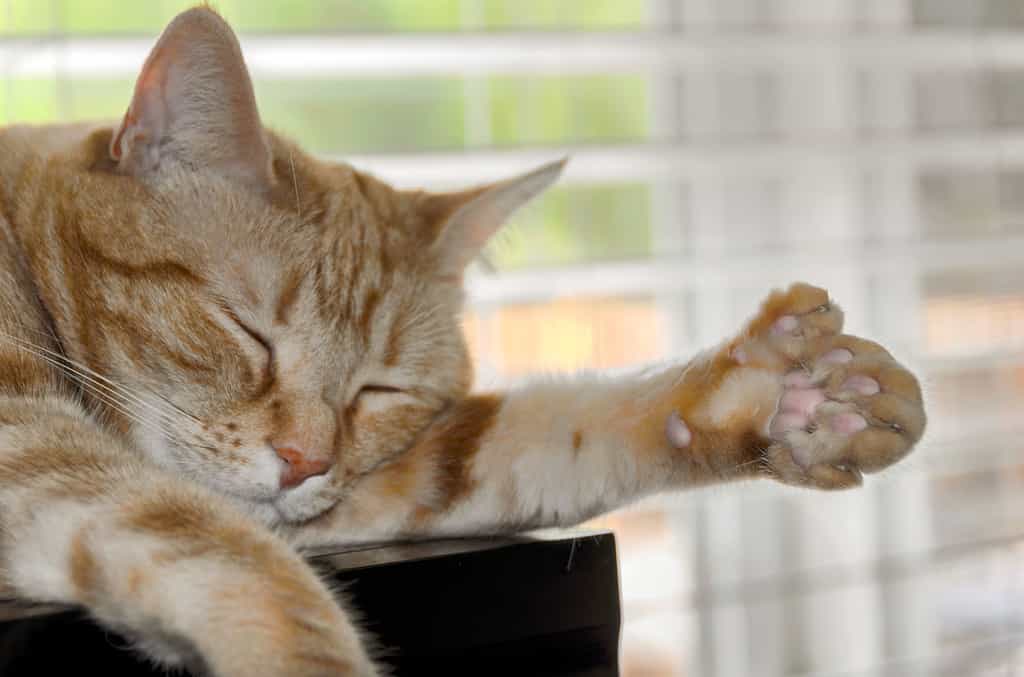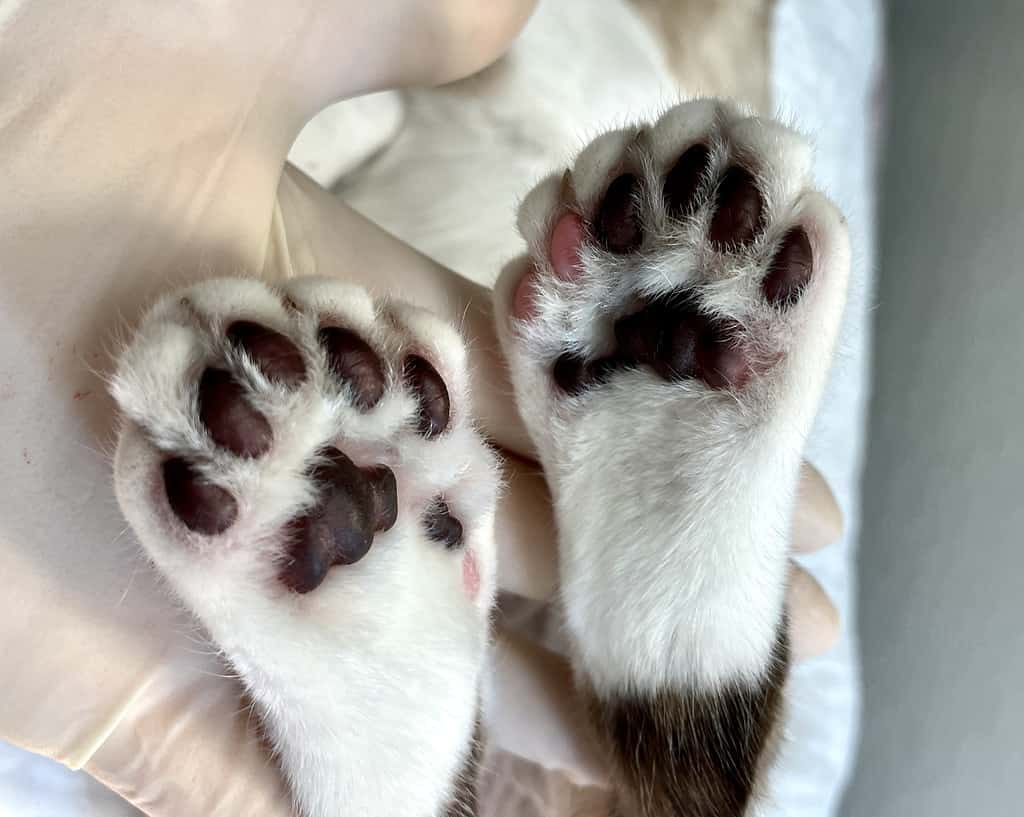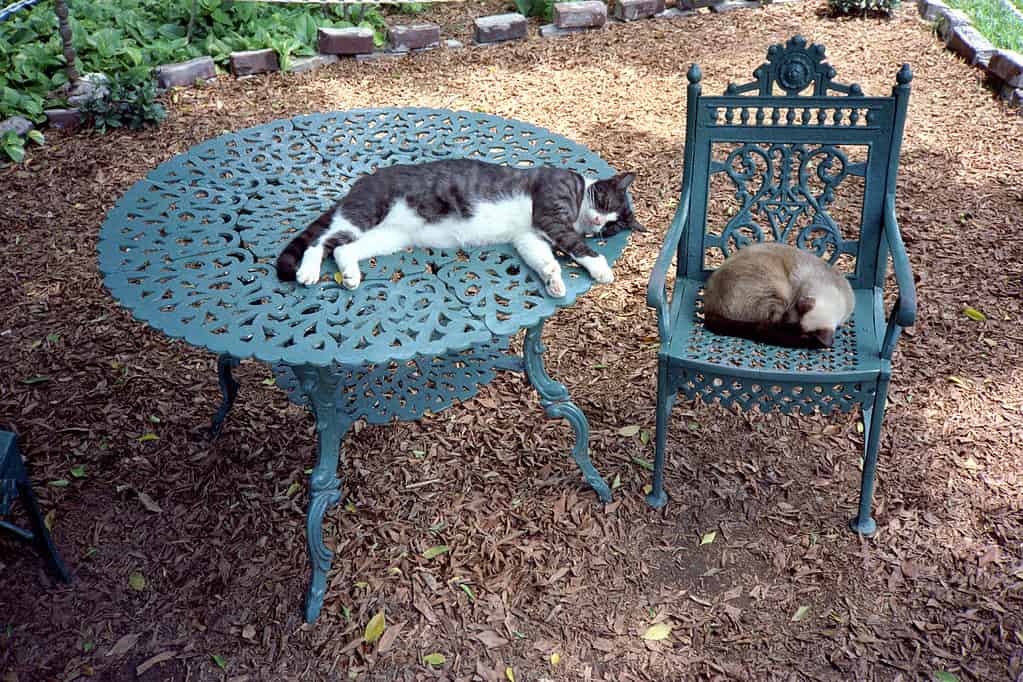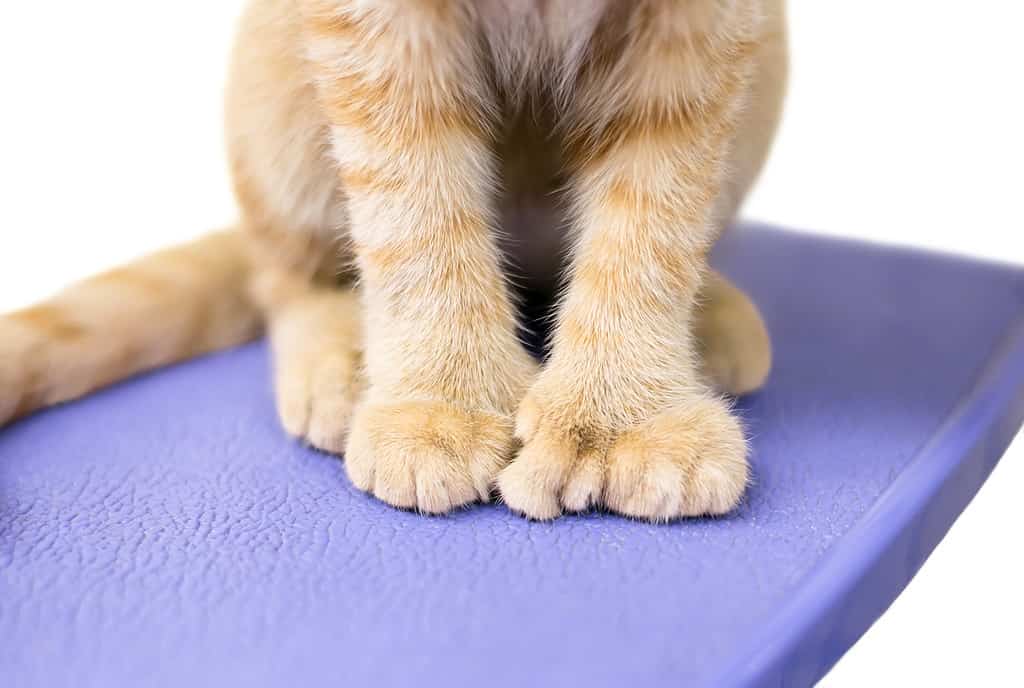Cat enthusiasts have coined a number of adorable terms for describing their feline friends. A common favorite is the apt descriptor “toe beans”. Toes beans are the little squishy paw pads on the bottom of a cat’s foot, which look like colorful little jellybeans! But did you know that there are special cats out there with a surplus of toe beans? Meet the amazing polydactyl cat — the unusual feline with extra toes!
What Is a Polydactyl Cat?

Many people call polydactyl cats “thumb cats” because they often look like they have an extra thumb.
©Ed-Ni-Photo/iStock via Getty Images
The term “polydactyl” originates in Greek and means “many digits” (i.e. toes or fingers). So, simply put, a polydactyl cat is a regular cat who has extra toes! Usually, cats have 18 toes — five toes on their front paws and four toes on their back paws. Polydactyl cats, however, have six or more toes on at least one paw. Typically, these extra toes only form on a cat’s front paws, but on occasion, they may also occur on the back paws.
These extra toes change the overall shape of the cat’s foot, causing polydactyl cats to leave behind unusual footprints. These look more like mittens than kitty paw prints, which is why some people call polydactyl cats “mitten cats”, “snowshoe cats”, or “boxing cats”.
Polydactyl cats can come from any cat breed, big or small — it isn’t a specific breed, but rather a genetic trait. These cats typically have just one or two extra toes per foot, usually near their thumb. However, there are a few very rare cats with nine toes on a single paw, including a ginger tabby cat named Jake. Jake holds the world record for most toes on a cat with his incredible 28 toes!
Why Do Polydactyl Cats Have Extra Toes?

Cats have four toes on their back paws, but rare polydactyl cats can have a few extras.
©Karen Mueller/iStock via Getty Images
The extra toes on a polydactyl cat are caused by a rare genetic mutation passed on by their parents. It is an autosomal dominant trait (a gene on a non-sex chromosome) and only needs one allele from one parent to manifest. In other words, if a kitten has one polydactyl parent and one parent with normal paws, there is a 40% to 50% likelihood that they will also have extra toes. However, it is impossible to predict just how many toes a polydactyl kitten will have, and it often differs from their polydactyl parent.
The majority of polydactyl cats have extra toes on the inside (or “thumb side”) of their paw. However, on rare occasions, they may also develop toes on the outside or even in the middle of a paw. In addition, a polydactyl cat may have a different number of toes on each paw — many polydactyl cats have adorable, asymmetrical paws!
Toe Arrangement in Polydactyl Cats
- Postaxial: These polydactyl cats have an extra toe(s) on the outside of their paw (near their “pinky toe”).
- Preaxial: These polydactyl cats have an extra toe(s) on the inside or medial aspect of their paw (near their “thumb”).
- Mesaxial: These polydactyl cats have extra toe(s) in the center of their paw, making their paws appear to fan out. Cats with mesaxial polydactyly are very rare.
Where Do Polydactyl Cats Come From?

Some of the most famous polydactyl cats live at Ernest Hemingway’s home in Key West, Florida.
©Richard Gunion/iStock via Getty Images
Because it is a genetic condition, polydactyl cats are more common in certain areas of the world. Historically, pixie bob and Maine coon cats were thought to produce more polydactyl cats, although any cat breed can be polydactyl.
The first polydactyl cat(s) was likely due to a random mutation that they then passed down to their descendants. Sailors valued polydactyl cats and often kept them on their ships for luck. They believed that these special “sea cats” had more balance on their ships and were better pest controllers.
Today, polydactyl cats seem to be more common in Canada and the United States, particularly along the eastern coast. There are also populations found in Wales and a few parts of England. One of the most well-known populations of polydactyl cats, however, lives on the island of Key West in Florida.
Often referred to as “Hemingway cats” or “American polydactyl cats”, these Florida felines are not a separate breed of cat. They are the 60 or so polydactyl cats that still live at Ernest Hemingway’s estate today — some of which are the descendants of Hemingway’s beloved cat, Snow White. A ship captain gave Hemingway this little white polydactyl cat, and Hemingway fell in love with her extra toes. Hemingway was very fond of cats — especially the special ones with extra toes — and kept several at his home for company.
Do Polydactyl Cats Need Specialized Care?

The only difference between a regular cat and a polydactyl cat is the number of toes they have.
©Mary Swift/iStock via Getty Images
Despite their surplus toes, Polydactyl cats are perfectly normal, healthy cats! However, there are a few extra things to think about if you are lucky enough to share your home with a polydactyl cat:
- Nail trimming: Polydactyl cats have extra toes, which means a few extra nails for trimming. This also means that there is a higher chance of overgrown nails, which can lead to breaks, snags, and infections, so it is important to examine your cat’s paws regularly. In very rare instances, one of the extra toes may not form correctly, causing a claw problem (similar to an overgrown or ingrown claw). However, this is very rare.
- Cleaning: Depending on the cat and the arrangement and number of their toes, there may be extra spaces for dirt and debris to collect. Be sure to keep an eye on your cat’s toes and clean them whenever necessary.
- Movement: If your cat is struggling with one of their paws, favoring one when walking, or any other noticeable changes, be sure to schedule an appointment with your vet. If for some reason their extra toes are causing an issue, they can be surgically removed without much bother.
The photo featured at the top of this post is © Karen Mueller/iStock via Getty Images
Thank you for reading! Have some feedback for us? Contact the AZ Animals editorial team.







